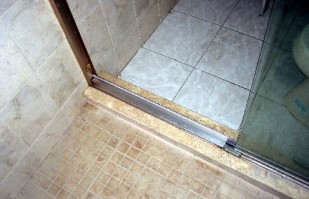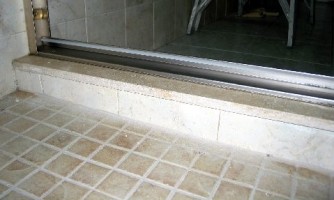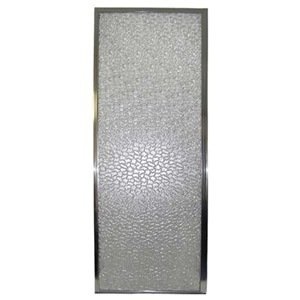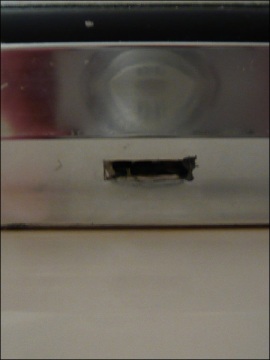Archive
Buying Shower Doors and Enclosures Online
More and more people are shopping online these days. It is a convenient way to shop for a lot of different items. People even buy shower doors online, if you can believe it! There are a lot of options available, and some are actually quite good. Showcase Shower Door Company carries a full line of shower doors and enclosures manufactured by Fleurco. They are some of the finest shower enclosures you will find anywhere. We can offer our customers a complete package including the shower pan, glass, hardware, and instructions. All of this delivered right to your front door!
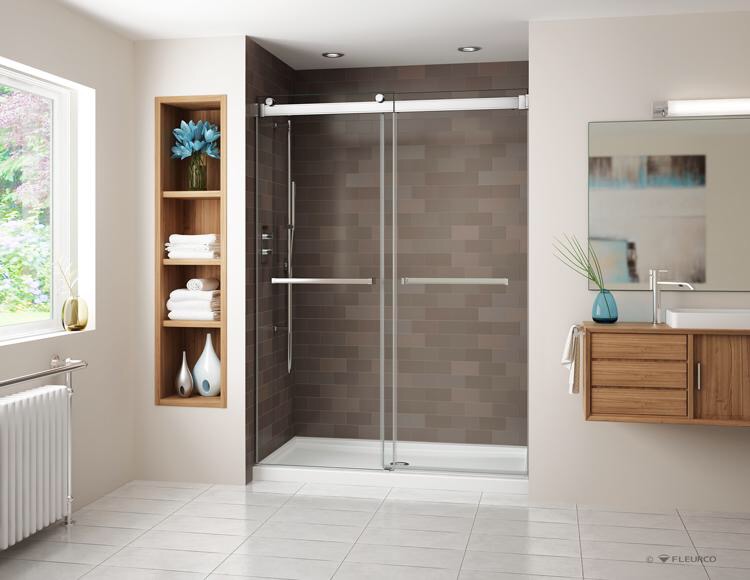
There is the challenge, however, of getting your shower enclosure installed once it arrives. We offer the service of installing customer-supplied shower enclosures for people in our area, whether they buy it from us or not. Wherever it is that you live, there is a good chance that there is a qualified shower enclosure installer available in your area. We here at Showcase Shower Door Company are taking steps to put together a network of quality shower door installers in different parts of the United States. We hope to be able to refer these experts to people who need their services. This will also allow shower enclosure manufacturers who sell their products across the country to take advantage of the skills of qualified installers in every area. Anyway, it’s something we are working on, and I’ll let you know as things develop.
RE: Bathtub Shower Door
Hello, I’m trying to install tub shower door. When I put in the inside panel the bottom part touches the bottom bumper but on the top there is a two gap. I tried adjusting the rolling wheels but nothing workings. I’m thinking of either cutting the wall jamb on the side of the gap or put something on the other wall jamb to raise it a little higher. If you could please advice on what I should do ? Thank you for your help.
Hi Francisco,
The problem you are having is caused by a bathtub that is way out-of-level, or a wall that is way out-of-plumb. In order to give you the correct advice, I would need to know if it is one or both of these issues.
If you are unable to get the sliding panels to line up with the wall jambs properly, and are thinking of leveling out the header by cutting one jamb, or shimming the other one up a bit, there are a couple of things to think about. If you cut one of the jambs, and you cut it too short, the corner of the door will hit the sill when it slides to the short side. If you shim the other jamb up, you run the risk of the panel coming out of the guide when it slides to the tall side…
The proper way to address this is to use an insert under the sill or behind the jamb (between the jamb and the tile). First you need to find out which you are going to need… Is the wall leaning out-of-plumb two inches? If so, you will need an insert for that jamb. The manufacturer of the enclosure will be able to provide one of these for you. It is a length of aluminum that is the same overall height of the one that came in your kit, but will be wider at the top (or bottom) as needed to correct the outage. If the outage is at the bottom (the tub), the same approach can be taken… the manufacturer can supply a length of aluminum that will fit between the tub and the sill of the enclosure.
Let me know if this is helpful,
Chris Phillips
Showcase Shower Door Company
No Weep Holes?
Hi, Chris.
We had one of our baths redone a few years ago but the apartment has been empty ever since as we were away from the country. A the time, a frameless door was installed and we never thought about looking for weep holes on the track until now that we found your blog. The shower has never been used so we don’t know if water would collect on the track.
Our question: Is there such a thing as a shower door track without weep holes? The photos show –instead of a conventional channel– a sloped, low lip on the side of the pan with no room for holes even if we wanted to drill some. Our guess was that, with this type of slanted lip, weep holes are not needed as water will just slide down onto the pan. We also checked if the track has been installed with the wrong side facing the pan but we failed to find weep holes on the other side as well.
Your clarification will be greatly appreciated. All the best to you.
Diana
Hi Diana,
Great question! Actually, this type of shower enclosure doesn’t require holes in the frame in order for the water to weep. The “L” shape of the bottom sill allows the water to run off back into the shower. As a rule, the sill is caulked on the outside only, or the inside is only partially caulked. This allows water the finds its way under the sill to escape, or at least dry out over time.
Thanks for reading the blog!
-Chris
Sliding Shower Doors in Small Spaces
Hi,
I want to purchase frameless shower doors for my walk in shower 42 ¾ across and 72 height. Why can’t I use frameless shower doors that were manufactured for a tub. People at the Big Box stores are telling me no.
thanks so much.
Michelle
Hi Michelle,
If you are talking about using the sliding shower doors that are normally used on bathtubs, then there is a problem… Your 42-1/2” opening will not allow you to have the 22” minimum opening that is required by building code after the glass is installed.
I’m guessing this is the reason for why the “Big Box” people are telling you no.
I hope this helps,
Chris Phillips – Owner
Showcase Shower Door – CCL #957120
1970 17th Avenue #C – Santa Cruz, CA 95062
Phone: (831) 464-3899 – FAX: (831) 477-0760
http://www.ShowcaseShowerDoor.com
From: Michelle-GCMarketing [mailto:michellek@gcmarketing.us]
Sent: Saturday, March 15, 2014 6:53 AM
To: chris@showcaseshowerdoor.com
Subject: frameless shower door question
Can I replace the aluminum in my shower enclosure and reuse the glass?
Hello,
I m living on Miramar Florida, i plan to sell my house but I need to repair the existing aluminum gold shower door trims of my two bathrooms, the house was built in 1997 with the original shower door enclosures and i would like to fix them if its possible without changing everything.Is that possible?
Regards
Cyril
Hi Cyril,
This is probably the most common question I am asked. Basically, “can I replace the aluminum in my standard shower enclosure and reuse the glass.” The short answer is “no.” Since I do get asked this question a lot, I am going to address this in detail now. That way, I can always just share the link to this article later.
Many people mistakenly believe that the glass in their shower enclosure is the most expensive part, and that they can somehow save money by reusing it, and replacing the aluminum extrusions. There are five or six reasons why this is not going to work, but there is no reason to cover all of them here… we’ll just look at a couple:
First, the most expensive part of your shower enclosure is the labor. The second most expensive part of your enclosure is the aluminum. That’s right! Your glass is actually the least expensive part of your shower enclosure! The standard enclosure that is bought “off the rack” from a home improvement store or a glass supplier is manufactured in a factory. Sometimes in China, or some other foreign country. The workers who build these enclosures in factories, even if they are located in the US, are paid a relatively low wage. The work is considered “low skill.”
The person who installs your shower enclosure, on the other hand, is a skilled worker. He earns a much higher wage. To hire the higher wage earner (an installer) to do the work of a lower wage earner (a factory worker) is not a cost efficient use of resources. Even if you could hire someone to track down the particular brand of aluminum from the manufacturer (there are dozens if not hundreds of different ones), how good a job will that person do at duplicating the parts of your enclosure that need to be replaced?
If the best possible result is achieved, you will end up paying more than your enclosure was worth when it was new, in order to hire someone to refurbish your used shower enclosure. What will you have when you are done? A used shower enclosure! What could you hope to save in terms of dollars? $100? $200? I doubt it. You could try to do the work yourself, but is it really worth trying? What if it ends up worse than before? What if you break a piece of glass? What if the shower leaks when you’re done?
You already have a used shower enclosure. The only reasonable options are to clean it up as best you can, or replace it.
Best regards,
-Chris
Installing Customer-Supplied Shower Enclosures
From time to time I am contacted by a potential customer who has purchased a shower door or enclosure elsewhere. They have found a “great deal” on a shower door online, or at a local home improvement center. Now they need to find someone who knows how to install it for them. My policy is never to install a customer-supplied shower door. There are just too many things that can go wrong. Online suppliers and home improvement stores are there to sell shower doors to people who are capable of installing them. It’s just common sense that, if you don’t know how to install a shower door, you probably aren’t qualified to buy the right one in the first place. Chances are that the customer thinks they are going to save a little money by buying the materials from one store, and having it installed by someone else. This is a big mistake. A customer who is looking for the cheapest way to do something is a disaster waiting to happen!
I have been doing business with a number of different suppliers for many years. There are a lot of great products available from local manufacturers. On the other hand, there is a lot of cheap crap that is made in China. Odds are that the guy who has done a Google search for “the cheapest shower door on planet Earth” hasn’t come up with a very high quality enclosure. I learned early on that it was a really bad idea to get involved in partnering with people who want to go this route. There are few things less enjoyable then being in a stranger’s bathroom with a shower door kit from some far-off land… hundreds of little parts that are made of inferior metals (or plastic instead of metal!) Instructions that were written by someone who obviously doesn’t speak English, and having the materials crumble under the smallest amount of pressure. Great! Not only have I wasted my day trying to install this piece of junk, now I look incompetent, and have to buy this guy a new crappy shower door and try to get out of this mess! No thank you!
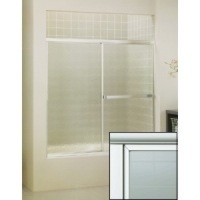
Recently, I let a customer talk me into installing his shower door (bought online). I told him that “I don’t install customer-supplied shower doors.” But he was such a nice guy, and practically begged me to do it. I have a soft spot for people who are in need, and it’s hard for me to say “no.” It had been years since I had agreed to install one of these things, and had forgotten what a nightmare it was to do this. I explained that it was going to be expensive. I went over the price with him a few times to me absolutely sure he understood how much it would cost. To make a long story short, after installing the shower door, the guy didn’t want to pay me. Go figure! It was just what I needed to remind me that my policy is a good one. Never install a customer-supplied shower enclosure.
Attaching Enclosures to Cast Iron Shower Pans
Chris,
I have a Kohler Salient Porcelain enamel cast iron shower pan. My wife wants a frameless pivot door for this. With a 60″ opening, is there adhesive strong enough to bond to the pan without a mechanical screw connection? One installer claimed he “routinely” screws into the cast iron base. I am concerned about chipping and rusting. Any suggestions?
Jeffrey

Hi Jeffrey,
Your shower opening is going to require a fixed panel and a door. The door will not pose any problem, as the hinges will be anchored to the wall, and not to the shower pan. The fixed panel is the part that is going to be at issue. You have a couple of standard options for your fixed panel… it can be attached using glass clamps, or it may be attached using a channel. I would say that, in my experience, people are evenly divided between these two options. There is no doubt that the channel offers a more waterproof solution than the brackets, but many people feel that the clamps give the enclosure a more “frameless” look. Either way you should be able to avoid drilling your pan, if it’s really important to you to do so.
If you decide to use an aluminum “U” channel to secure your fixed panel, you can definitely have the bottom channel glued into place with silicone or a high-strength epoxy. That is providing the vertical channel is anchored to the wall using screws. If using glass clamps, you can place them on the vertical wall edge only, and use clear silicone to secure the bottom edge. A third option is the “saloon door” style enclosure. In this configuration, both panels are hinged, eliminating the need for any bottom attachment.
Now, all of that being said, I also routinely use screws in cast iron tubs and pans. Using stainless steel screws and plenty of silicone to keep the area dry is the key. You shouldn’t have any issues, providing the installation is done properly.
Thanks for writing,
Weep Holes Allow Water to Drain Out of the Shower Frame and Into the Shower.
Hello!
I saw you through Google and hoped you may be able to answer my question. I am re-caulking my shower enclosure and I noticed that there are some slots along the bottom of the inside of my shower enclosure. Before removing the caulk, these slots were harboring mildew and mold and spewing it out in gobs. the caulk ran right under these slots and it too became black and ruined. My question is whether these should be caulked over or not. Since water seems to be getting in there and it never dries out, I assume that it is getting in there primarily from the front. But, if there is some other reason why these need to be open, such as draining water that gets in there from elsewhere, then obviously I wouldn’t want to caulk over them. What do you think? Thanks!
Daniel Wells
Hi Daniel,
Yes, those are what we call “weep holes.” They are necessary, as you guessed, to allow the water to drain out of the frame and into the shower. I would suggest spraying a bleach solution into the holes from time-to-time to try to inhibit the mold growth in the framework. If the base of the shower itself (shower pan or tile curb) doesn’t slope into the shower properly, the water will never completely drain out of the aluminum channel at the bottom. There will always be some standing water in there, and that is going to create mold.
There are a few ways to get the water out manually. One is to use a shop-vac or some other vacuum that is approved for wet situations. You could also use a blow drier to force the water out of one hole by directing the flow of hot air into another hole. One other low-tech method of drawing water out is by using a cotton wick. This is simply a piece of string (yarn?) that draws the water out of the channel… you simply work one end of the string into the weep hole, and let the other end hang down into the shower pan. The capillary action of the water being absorbed will actually siphon the water out of the channel and down the drain.
Best wishes,
-Chris
Is it Possible to Reuse the Glass in My Exisiting Shower Enclosure?
Chris,
I was told by a friend that I could use the current glass I have in my shower to create a seamless or frameless shower. Can that be done? I have a gold frame now, but want it frameless.
Thanks,
Terry
Hi Terry,
It may be possible to reuse glass from your framed shower enclosure to create a frameless one, but I have never heard of anyone doing it. There are a lot of reasons why used glass from a manufactured enclosure wouldn’t work well in a frameless one. Here are a few things to consider:
1) The glass in a framed enclosure is (or should be) tempered safety glass. Tempered glass is impossible to cut, drill, or otherwise fabricate. You will be stuck using the glass exactly as it is in terms of its size and shape.
2) The glass in a framed enclosure is thin. Normally 3/16” to 1/4”. Much too thin to be practical in a frameless shower enclosure.
3) Once you get the glass out of the frame, you are likely to find that the edges are much different in appearance than the rest of the panel. Since the part of the glass that has been hidden from view has also been spared from exposure to the elements, there is going to be a visible difference.
4) Consider the hazards. Even though tempered glass is safer than regular plate-glass, it can still cut you. I have an employee who had to get a few stitches from a broken piece of tempered glass. Reusing glass in a shower enclosure would be a lot of work for even an experienced glazier, and would yield results the probably wouldn’t be all that impressive.
In my opinion, it just isn’t worth the effort that it would take to take on this kind of a challenge. You may get it to work, but you aren’t going to end up with the beautiful frameless glass enclosure that you really want.
Thanks!
-Chris
Tile Dilemma with Sliding Frameless Glass Tub Door
Hello Chris –
I have found your website most informative and helpful, and appreciate your experience and goodwill! We would currently like to install a new frameless glass sliding tub door across our standard 60 inch bathtub. We have an existing architectural detail that is challenging us. The tile listel and borders on either side of it protrude out where the sliding doors need to meet flush with the sides of the other tiles. I have enclosed some pictures that highlight our dilemma. Do you have any experience with a similar situation? Should a tile person cut a channel in the area of concern? If so, should the channel be lined with metal or finished in some other way? Your thoughts would be greatly appreciated. Cheers, Barbara and Scott
The protruding tile border near the top of the tiled bath enclosure requires slots to be cut into them on both enclosure sides so that the shower door can be installed flush with the vertical enclosure wall.
I’ve attached photos of the existing bath enclosure and of the proposed shower door.
So that the slots have a more finished look, I proposed to also install aluminum or stainless steel “U-brackets” inside the slots to cover the exposed cut tile. The U-bracket sides could be shaped (by me if necessary) to match the contour of the tile header. Does this sound reasonable to you? Or would the tile person create a “finished” surface to the channel?
Thank you for your consideration. We look forward to hearing from you.
Warm Regards,
Scott and Barbara
Dear Scott and Barbara,
Thanks for writing. Yes, this is a common issue, and normally, the trim tile does get notched for the glass to sit flush with the adjacent tile. I have never seen a situation where the area was inlayed with a channel, the way that you are proposing. It sounds like a pretty good idea, though.
The biggest challenge is always getting the notches laid out correctly, assuring that they are in the proper location before the cutting begins.
Feel free to contact me if you have any additional concerns.
Thanks again,
Chris Phillips – Owner

